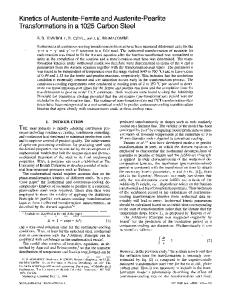Load sharing between austenite and ferrite in a duplex stainless steel during cyclic loading
- PDF / 1,912,395 Bytes
- 14 Pages / 612 x 792 pts (letter) Page_size
- 90 Downloads / 312 Views
I. INTRODUCTION
DUPLEX stainless steels, consisting of approximately equal amounts of austenite and ferrite, are established today in a wide product range from chemical tankers, pressure vessels, and pipes to heat exchangers, paper machines, and offshore applications. The high strength of the duplex grades enables both weight and cost savings when they are used as corrosion resistant materials in a construction. The use of duplex stainless steels in load carrying applications has increased the demand for thorough knowledge of the fatigue mechanisms in these materials. Magnin et al.[1,2] studied the low-cycle fatigue behavior of the duplex alloy 22Cr-7Ni2.5Mo-1.7Mn-0.07N. They found that crack initiation was related to the cyclic deformation mechanisms of ferrite at high plastic strain amplitudes («pl . 1023) and to those of austenite at relatively low «pl. These results are supported by later studies on duplex stainless steels with higher nitrogen content.[3,4] Degallaix et al.,[5] on the other hand, investigated the duplex alloy 22.1Cr-5.4Ni-3.1Mo-1.7Mn-0.11N, in wt pct, and 22.2Cr-5.5Ni-3.1Mo-0.9Mn-0.18N and found that crack initiations were observed exclusively in the ferrite at lowstrain amplitudes and indifferently in both phases at higher strain amplitudes. Similar results are found by Polak et al.[6] who studied polished specimens of duplex stainless steel type 2205 with 0.11 pct nitrogen. They found that crack initiation starts at persistent slip bands in the ferrite. The persistent slip bands were generally more numerous in the ferritic grains, and only a few cracks were initiated at slip markings in the austenitic grains. JOHAN JOHANSSON, Graduate Student, and MAGNUS ODE´N, Research Associate, are with the Division of Engineering Materials, Department of Mechanical Engineering, Linko¨ping University, S-581 83 Linko¨ping, Sweden. Manuscript submitted August 23, 1999. METALLURGICAL AND MATERIALS TRANSACTIONS A
These inconclusive results might be explained by the internal stress state in the material. Residual microstresses are always present in duplex stainless steels due to the difference in coefficient of thermal expansion between the two phases. A large variation in residual thermal stresses, both measured and calculated, has been reported in the literature,[7–10] and it is clear that texture effects and plastic relaxation will influence these stresses.[9] Johansson et al.[9] has shown that these residual microstresses can change during deformation due to different elastic and plastic properties of the two phases. It is, therefore, likely that microstresses influence the plastic strain and, thus, also the cyclic slip localization causing fatigue crack initiation. Residual stresses in a material can be measured by Xray diffraction (XRD) using well-established procedures.[11] This technique allows for determination of the triaxial stress tensor in each phase separately and has been successfully used for studying load sharing between phases and effects of microstresses on the fatigue behavior in a 1080 ste
Data Loading...











